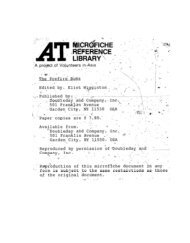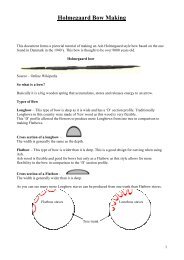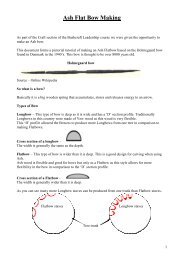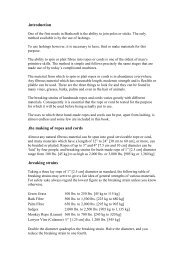Experiments on Knife Sharpening John D. Verhoeven ... - BushcraftUK
Experiments on Knife Sharpening John D. Verhoeven ... - BushcraftUK
Experiments on Knife Sharpening John D. Verhoeven ... - BushcraftUK
You also want an ePaper? Increase the reach of your titles
YUMPU automatically turns print PDFs into web optimized ePapers that Google loves.
[7] <str<strong>on</strong>g>Experiments</str<strong>on</strong>g> <strong>on</strong> carb<strong>on</strong> steelsA series of experiments was d<strong>on</strong>e <strong>on</strong> the carb<strong>on</strong> steel blades having the geometryshown in Fig. 6 and the compositi<strong>on</strong> and hardness shown in Table 2. The main purposeof this study was to evaluate the effect of reducing the hardness of the steels from theHRC = 60 level to the HRC = 40 level. The c<strong>on</strong>venti<strong>on</strong>al steels, 52100 and 1086, wereheat treated to final hardness of Table 2 by quench and tempering treatments. TheDamascus steel was a 1.6 % carb<strong>on</strong> steel of the genuine Damascus type [6] that was oilquenched from below it’s A cm temperature to produce the HRC 40 hardness value. It wasa pearlitic steel, while the other steels were quenched and tempered martensitic steels.<str<strong>on</strong>g>Experiments</str<strong>on</strong>g> with the TruH<strong>on</strong>e machineThese experiments utilizedthe 1000 grit wheels of the TruH<strong>on</strong>e machine for the final grinding after an initial grindwith the 600 grit wheels. The initial experiments were d<strong>on</strong>e with a 2β edge angle of 38degrees using the same procedure as used with the stainless steel blades discussed <strong>on</strong>page 8 except that the 2β edge angles <strong>on</strong> both the 600 and 1000 grit wheels wasdecreased by 3 degrees. Figure 45 presents face views of three steels with HRC varyingfrom 40 to 60. The results show that at the reduced hardness of HRC = 40 there is adefinite increase in the degree of edge roughness.These carb<strong>on</strong> steel blades were used in the study with the TruH<strong>on</strong>e machineaimed at reducing the 2β edge angle to the minimum possible values. The initialexperiments were d<strong>on</strong>e at 2β value of 20 degrees. At this small angle the operator couldfeel a definite vertical pulsating moti<strong>on</strong> as the blades passed over the wheels. At 20degrees the wheels of the TruH<strong>on</strong>e machine used here had a very small overlap. Hence,any out-of-round wheel shape leads to a significant up-and-down pulsating moti<strong>on</strong> as theedge of the blade passes over the wheels. This acti<strong>on</strong> produces edges that are notstraight. It was c<strong>on</strong>cluded that a 2β edge angle of 20 degrees was too small for goodsharpening, and a series of blades were d<strong>on</strong>e at what seemed to be the smallest angle37








